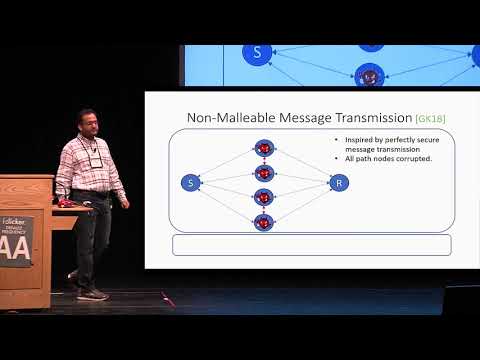Welcome to the resource topic for 2018/750
Title:
Non-Malleable Secret Sharing for General Access Structures
Authors: Vipul Goyal, Ashutosh Kumar
Abstract:Goyal and Kumar (STOC’18) recently introduced the notion of non-malleable secret sharing. Very roughly, the guarantee they seek is the following: the adversary may potentially tamper with all of the shares, and still, either the reconstruction procedure outputs the original secret, or, the original secret is destroyed" and the reconstruction outputs a string which is completely unrelated" to the original secret. Prior works on non-malleable codes in the 2 split-state model imply constructions which can be seen as 2-out-of-2 non-malleable secret sharing (NMSS) schemes. Goyal and Kumar proposed constructions of t-out-of-n NMSS schemes. These constructions have already been shown to have a number of applications in cryptography. We continue this line of research and construct NMSS for more general access structures. We give a generic compiler that converts any statistical (resp. computational) secret sharing scheme realizing any access structure into another statistical (resp. computational) secret sharing scheme that not only realizes the same access structure but also ensures statistical non-malleability against a computationally unbounded adversary who tampers each of the shares arbitrarily and independently. Instantiating with known schemes we get unconditional NMMS schemes that realize any access structures generated by polynomial size monotone span programs. Similarly, we also obtain conditional NMMS schemes realizing access structure in monotoneP (resp. monotoneNP) assuming one-way functions (resp. witness encryption). Towards considering more general tampering models, we also propose a construction of n-out-of-n NMSS. Our construction is secure even if the adversary could divide the shares into any two (possibly overlapping) subsets and then arbitrarily tamper the shares in each subset. Our construction is based on a property of inner product and an observation that the inner-product based construction of Aggarwal, Dodis and Lovett (STOC’14) is in fact secure against a tampering class that is stronger than 2 split-states. We also show applications of our construction to the problem of non-malleable message transmission.
ePrint: https://eprint.iacr.org/2018/750
Talk: https://www.youtube.com/watch?v=vIU8wd_4G-Y
See all topics related to this paper.
Feel free to post resources that are related to this paper below.
Example resources include: implementations, explanation materials, talks, slides, links to previous discussions on other websites.
For more information, see the rules for Resource Topics .
